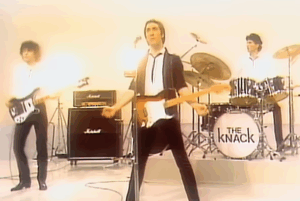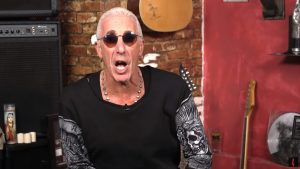Songs People Thought Were Secretly Satanic—But It’s All Just Rumors

Led Zeppelin, 1971 c/o official band site
The idea that rock music hides sinister secrets has been around for decades, fueled by the paranoia of parents, preachers, and self-proclaimed watchdogs of morality. For some, the notion of “backmasking” — playing records backwards to uncover hidden messages — became proof that musicians were secretly spreading satanic messages. In reality, these theories often said more about the fears of listeners than the intentions of the artists.
Most of the supposed evidence came from people hearing things that weren’t really there. Play a record backwards, and your brain is bound to stitch together nonsense into something familiar. Sometimes it was a vague phrase that could be interpreted a dozen ways; other times it was simply the original lyrics reversed, hardly the stuff of dark rituals. Yet rumors took hold, and entire bands found themselves accused of dabbling in the occult without ever meaning to.
What makes these stories so enduring isn’t the accuracy of the claims but the creativity of the mishearings. Fans, critics, and alarmists alike have “discovered” messages that range from eerie to laughable, painting ordinary songs as vessels of hidden evil. The truth is far less dramatic, but the myths are fascinating — a reminder of how quickly fear and imagination can reshape the meaning of music.
Led Zeppelin – “Stairway to Heaven”, Led Zeppelin IV (1971)
Nobody has ever really agreed on what “Stairway to Heaven” is actually about, and Robert Plant himself has admitted the lyrics came out in a near-trance. That ambiguity left plenty of space for wild theories, and in the early 1980s, televangelist Paul Crouch claimed the band had laced the song with hidden satanic messages. Supposedly, if you spun the “bustle in your hedgerow” section backwards, you’d uncover lines like “Here’s to my sweet Satan” and “There was a little toolshed where he made us suffer, sad Satan.”
The problem with this theory is that the so-called secret messages are awkward, nonsensical, and not particularly scary. “Satan’s power is Satan”? “Sad Satan”? If Led Zeppelin really wanted to summon the powers of hell, it’s hard to believe they would do it in clumsy, pseudo-poetic gibberish that wouldn’t pass for a bad goth teenager’s notebook scribble. The only way to hear any of it is to read the “lyrics” first and then convince yourself you hear them.
Still, the rumor took on a life of its own, cementing “Stairway to Heaven” as one of the most infamous examples of backmasking paranoia. To this day, it remains a case study in how easily suggestion can warp perception. Fans and critics alike ended up arguing over a “message” that almost certainly never existed, proving once again that the real story isn’t about Satan, but about the human imagination.
The Beatles – “Revolution 9”, The White Album (1968)
Few bands have attracted as many conspiracy theories as The Beatles, and one of the strangest came in the form of the “Paul is dead” hoax. According to the story, McCartney had died in 1966, been replaced by a lookalike, and the surviving Beatles left a trail of cryptic clues in their music to reveal the truth. Chief among these supposed hints was the avant-garde sound collage “Revolution 9,” a track already notorious for testing listeners’ patience.
Within its jumble of tape loops and sound effects, a voice repeats “number nine” over and over. When reversed, some listeners claimed it transformed into the phrase “turn me on, dead man.” That eerie coincidence quickly became “proof” that the Beatles were signaling McCartney’s death. Never mind that phonetic reversals can create all kinds of random phrases or that this particular one only made sense if you were already primed to expect it.
What’s remarkable is not the backward phrase itself but how willing people were to run with it. A monotonous chant in an experimental track became evidence of a global cover-up. In the end, “Revolution 9” wasn’t satanic, nor was it a secret obituary. It was simply another example of listeners hearing what they wanted to hear, even if it meant turning an odd artistic experiment into a ghost story.
Electric Light Orchestra – “Eldorado”, Eldorado (1974)
Electric Light Orchestra hardly seems like the kind of band to inspire satanic rumors. With their lush strings and spacey rock operas, they were more likely to soundtrack a dream sequence than a demonic ritual. Yet when fans began spinning “Eldorado” backwards, they thought they uncovered a chilling message. A line about sailing on a voyage of no return supposedly hid phrases like “He is the nasty one” and “Everyone who has the mark will live.”
Compared to the clumsy word salad of “Stairway to Heaven,” these reversed phrases almost sound polished, but that’s still giving them too much credit. Like most backmasking claims, they were the product of imagination filling in the blanks. Jeff Lynne himself dismissed the controversy by cheekily calling it “skcollob” — “bollocks” spelled backwards. Rather than get defensive, ELO leaned into the absurdity.
On their next album, the band even inserted intentional backwards messages, including one that declared, “Music is reversible, but time? Turn back, turn back!” Far from being satanic, it was a tongue-in-cheek jab at the hysteria. Ironically, even ELO’s parody had an unsettling edge, conjuring images of a doomsayer urging strangers to rewind the clock. Whether accidental or deliberate, their supposed dark side was more campy than diabolical.
The Eagles – “Hotel California”, Hotel California (1976)
For some listeners, “Hotel California” was already ominous enough with its surreal lyrics about strange voices, mirrors on the ceiling, and a place you can “never leave.” But in the 1983 book Backward Masking Unmasked, youth pastor Jacob Aranza took things further, insisting the song contained hidden satanic messages. According to him, reversing the opening verse revealed the phrase “Yes, Satan organized his own religion,” while later lines supposedly admitted, “Yeah, Satan hears this, he had me believe in him.”
It’s a stretch, to say the least. Don Henley’s tale of excess and disillusionment was cryptic, but it was hardly an invitation to join a cult. To buy into the rumor, you’d have to accept that middle-aged, laid-back California rockers were secretly missionaries for the devil. The imagery is compelling if you squint hard enough, but ultimately, it says more about the anxieties of the era than about the Eagles’ intentions.
Ironically, the band became a target of Satanic Panic not because of genuine darkness in their music, but because they wrote songs that lent themselves to mystery and interpretation. In reality, the devil probably wouldn’t waste his time on mellow tracks like “Take It Easy.” If “Hotel California” had anything to do with hell, it was only in describing the excesses of the rock lifestyle, not in recruiting fans for the underworld.
Justin Bieber – “Baby”, My World 2.0 (2010)
Satanic accusations aren’t limited to classic rock. Even Justin Bieber’s bubblegum-pop breakthrough, “Baby,” found itself accused of harboring dark secrets. On Tumblr, conspiracy theorists claimed that reversing the chorus revealed phrases like “I’m the evil one,” “Satanic new world,” and repeated pleas of “Let me in, let me in, yeah war.” It was a far cry from the harmless teenage anthem that dominated radio in 2010.
Of course, this interpretation requires a lot of imagination. The reversed chorus could just as easily sound like garbled nonsense, but once a “translation” is supplied, the ear tends to follow along. It’s the same psychological trick that fueled backmasking hysteria for decades: once you’re told what to listen for, you’ll convince yourself it’s there. The result is less a satanic revelation and more a case study in auditory suggestion.
At the heart of it, the rumor underscores how eager some people are to project hidden meaning onto pop culture. Bieber wasn’t ushering in a “new world order” at age 16; he was just singing the same word over and over to catchy effect. If anything, the only truly sinister element here was how effectively “Baby” lodged itself in listeners’ heads for weeks at a time.
Beyoncé – “Sweet Dreams”, I Am… Sasha Fierce (2008)
Beyoncé’s “Sweet Dreams” is a shimmering love song on the surface, but conspiracy theorists swore that reversing it revealed an ode to Lucifer. Online posts claimed they heard chilling chants like “Hail Satan,” “I am worthy,” and “I follow Lucifer.” According to this reading, Beyoncé wasn’t just a global superstar — she was a vessel for the devil himself.
The problem is that the alleged backwards lyrics are nearly impossible to make out without heavy prompting. Even if you try, they don’t line up with Beyoncé’s usual confidence and clarity. If she wanted to make a bold statement — about love, empowerment, or anything else — she’s never been shy about doing it directly. It’s far-fetched to think she would hide allegiance to Satan in a muffled reversal of a dance track.
Ultimately, the rumor feels more like satire than serious accusation. Beyoncé’s real power doesn’t come from imagined rituals or secret messages — it comes from commanding every stage she steps onto. If there’s anything to “worship” in “Sweet Dreams,” it’s her artistry, not a misheard backwards chant. The idea of her whispering cryptic satanic vows into the music is less frightening than it is absurd.

















